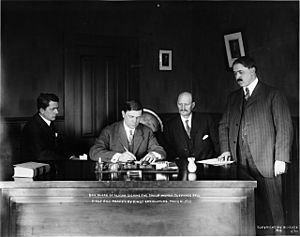Timeline of women's suffrage in Alaska facts for kids
This is a timeline of women gaining the right to vote in Alaska. The right to vote is also called suffrage.
White women in Alaska could vote in school board elections starting in 1904. In 1913, the first group of lawmakers for the Alaska Territory passed a law called the Shoup Suffrage Bill. This law gave white women the right to vote in all elections.
Alaska Native women had a much harder time getting their right to vote. First, they needed to be recognized as citizens of the United States. Even after this happened in 1924, other challenges appeared. These included tests to see if they could read and write (called literacy tests) and rules that kept people of different races apart (called segregation). The Voting Rights Act of 1965 later helped remove many of these barriers. This made it easier for Alaska Natives to use their right to vote.
Contents
The Right to Vote in Alaska
Early Steps: 1900s
1904
- Women in Alaska gained the right to vote in school board elections.
Big Changes: 1910s
1912
- A lawmaker named Frank W. Mondell added a change to a bill. This change allowed Alaska's lawmakers to give women the right to vote.
- Cornelia Templeton Hatcher wrote a request asking Alaska's lawmakers to give women the right to vote.
- Nellie Cashman was the first woman to vote in Alaska.
- The Alaska Native Brotherhood (ANB) was started. This group worked for the rights of Alaska Natives.
1913
- The Shoup Woman Suffrage bill became law. This bill gave women who were U.S. citizens the right to vote in Alaska.
- March 21: The Shoup Suffrage bill was officially signed into law.
1915
- The Alaska Native Sisterhood (ANS) was formed. This group also worked for the rights of Alaska Natives.
- Alaska Natives were told they could vote if they gave up their "tribal customs and traditions." This was a difficult choice.
Citizenship and Challenges: 1920s
1924
- The Indian Citizenship Act was passed. This law made all Native Americans citizens of the United States.
1925
- Alaska passed a literacy test law. This test made it harder for Alaska Natives to vote because they had to prove they could read and write.
Fighting for Fairness: 1940s
1943
- Chinese Americans gained the right to vote after a law called the Magnuson Act was passed.
1945
- The Alaska anti-discrimination law was passed. This law helped end segregation (keeping people of different races separate) for Native Alaskans.
New Organizations: 1950s
1950
- The Anchorage League of Women Voters (LWV) was started. This group works to help people vote and understand elections.
1959
- When Alaska became a new state, it had an easier literacy test for voting.
Major Progress: 1960s
1965
- The Voting Rights Act (VRA) was passed. This very important law helped remove many barriers that stopped Native Alaskans from voting.
1967
- The statewide LWV was formed, covering all of Alaska.
Ending Barriers: 1970s
1970
- Literacy tests for voting were finally ended in Alaska.
1975
- The VRA was changed to make sure voting information was available in Native languages.



